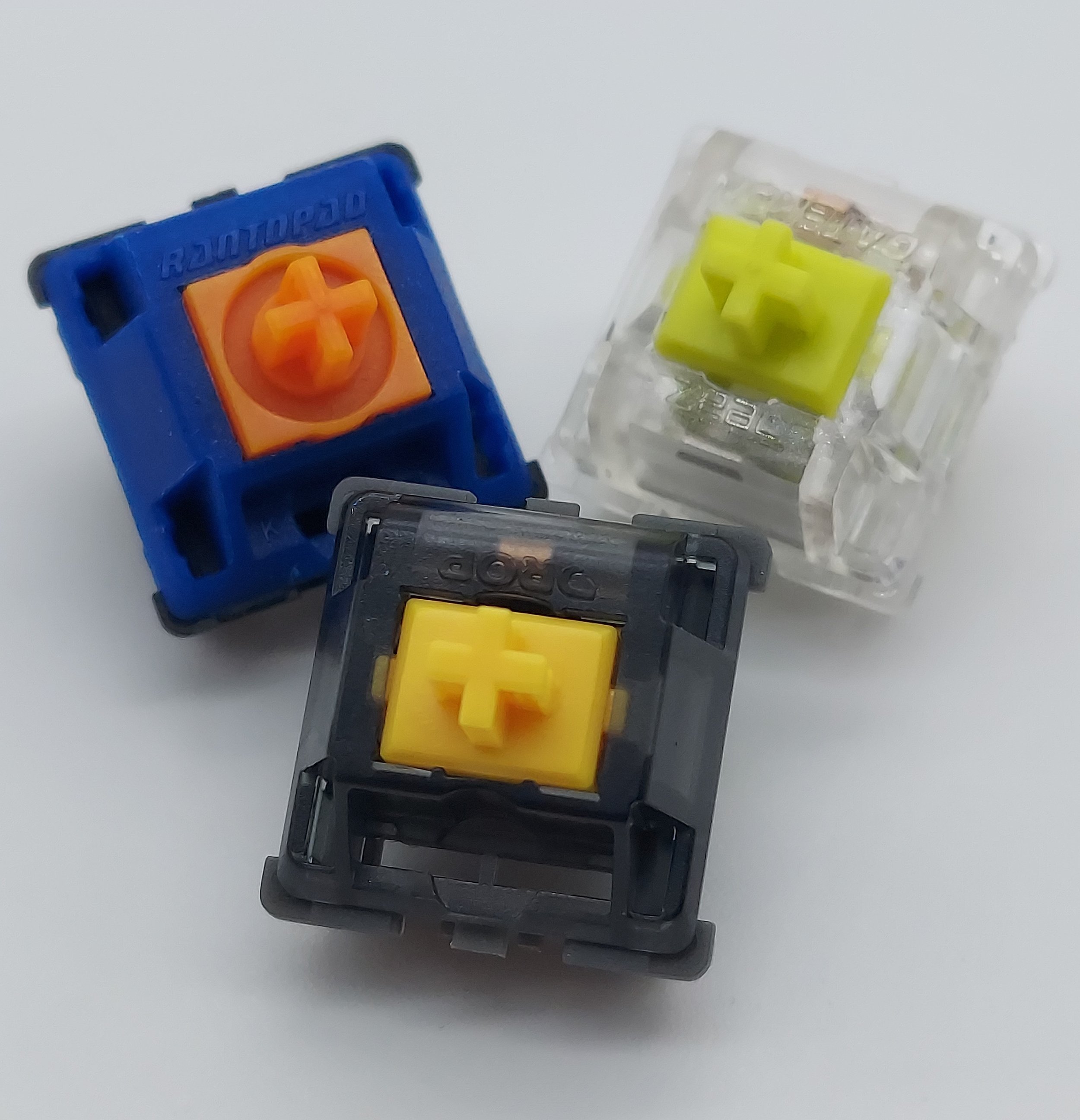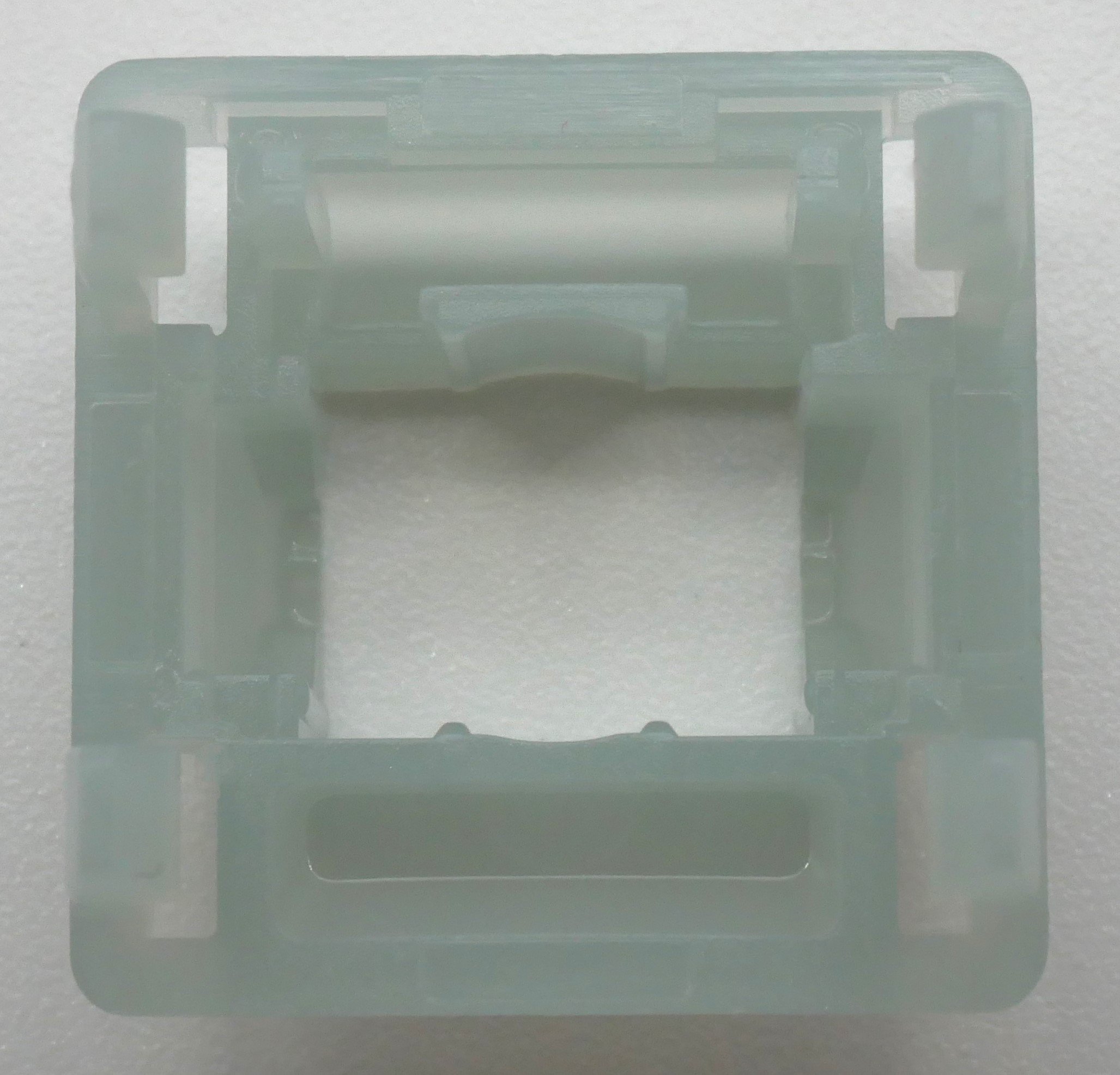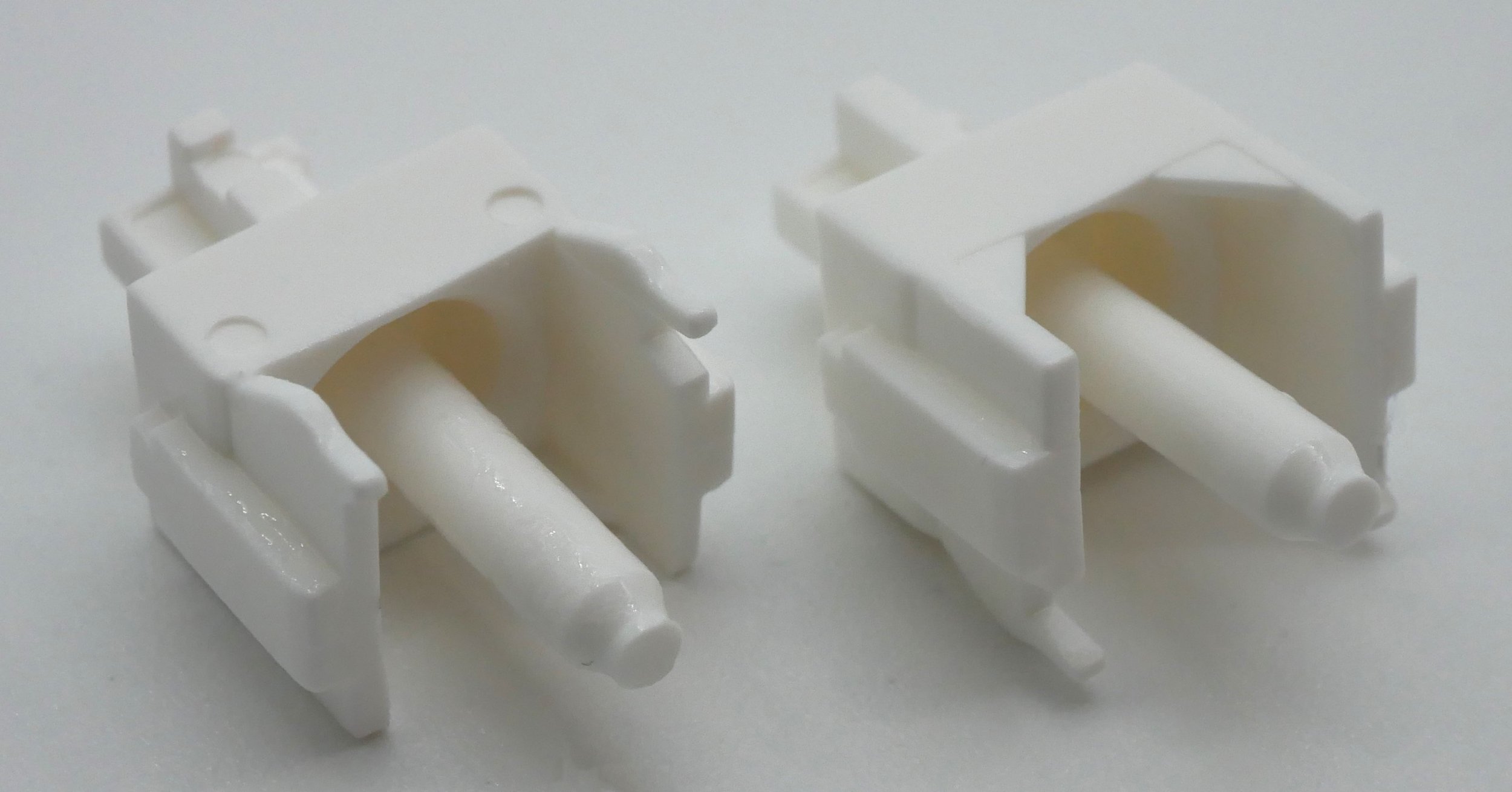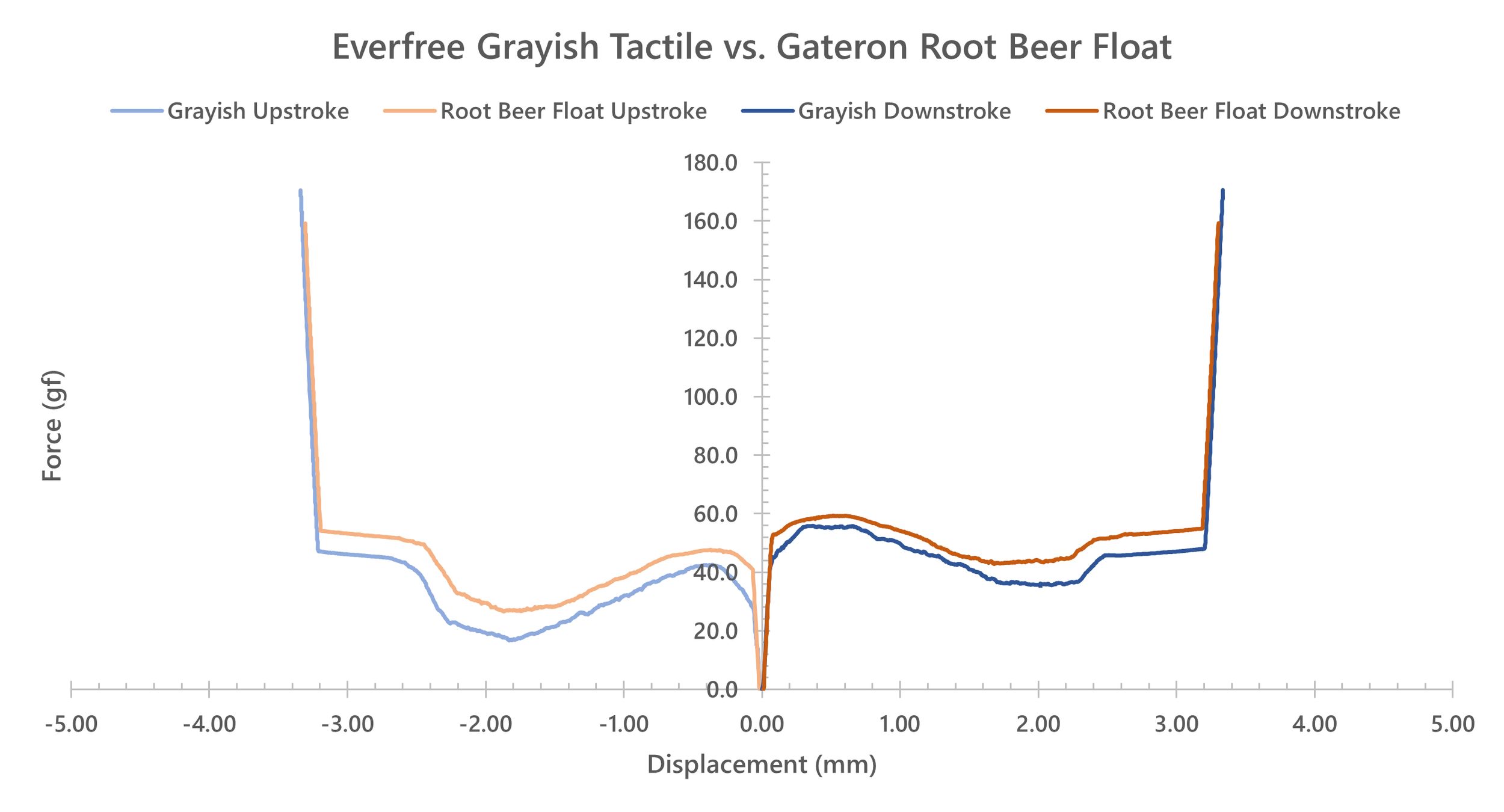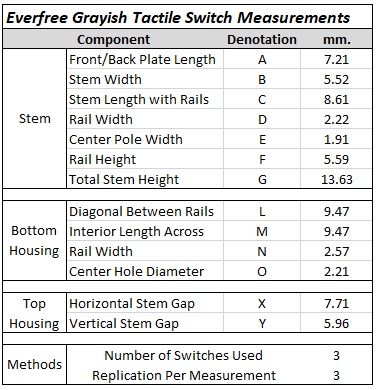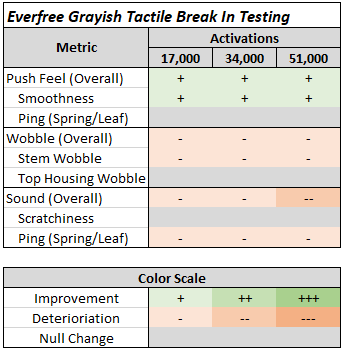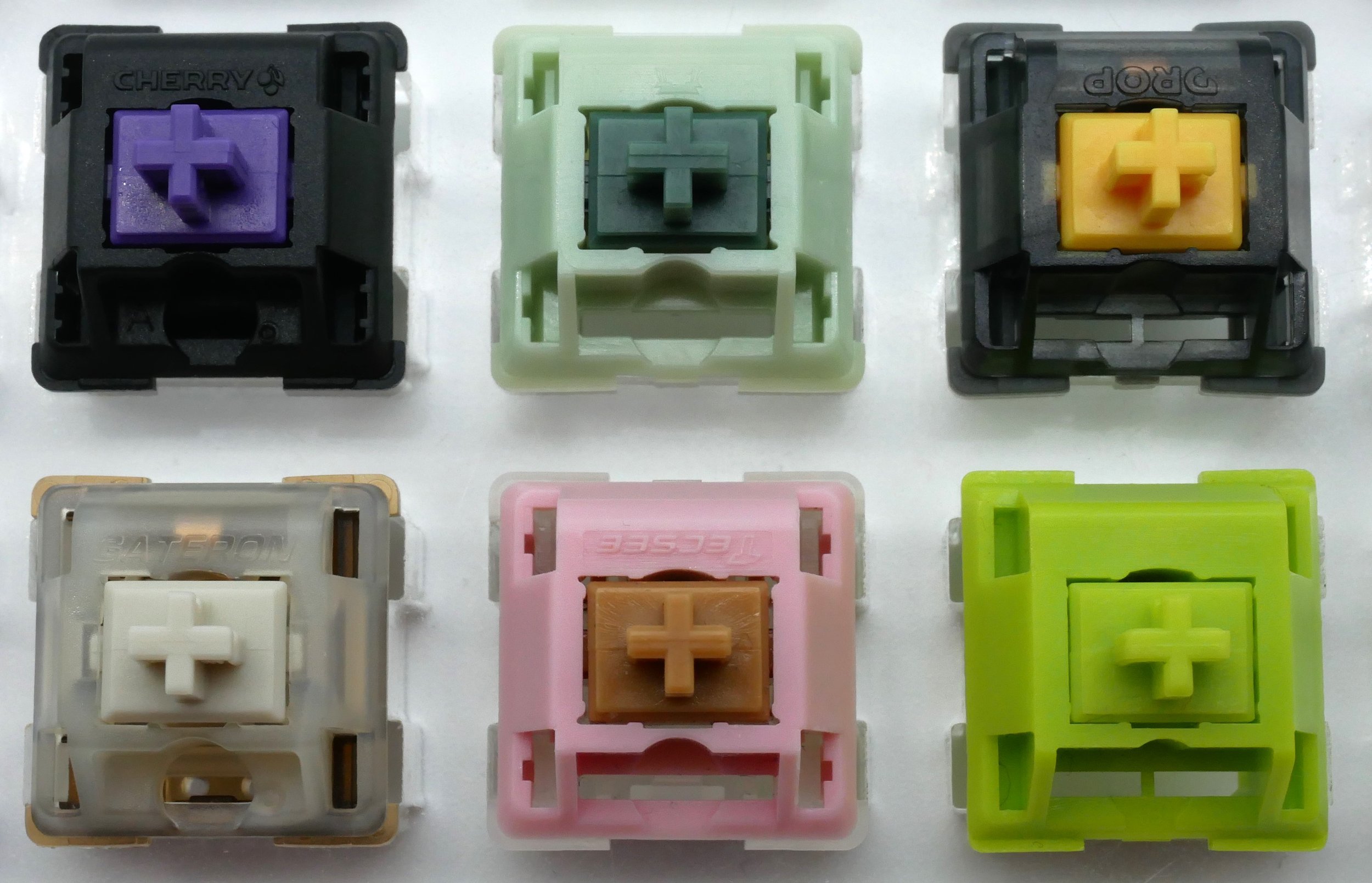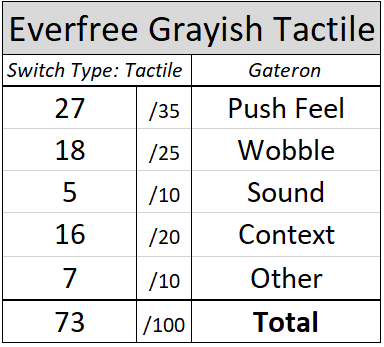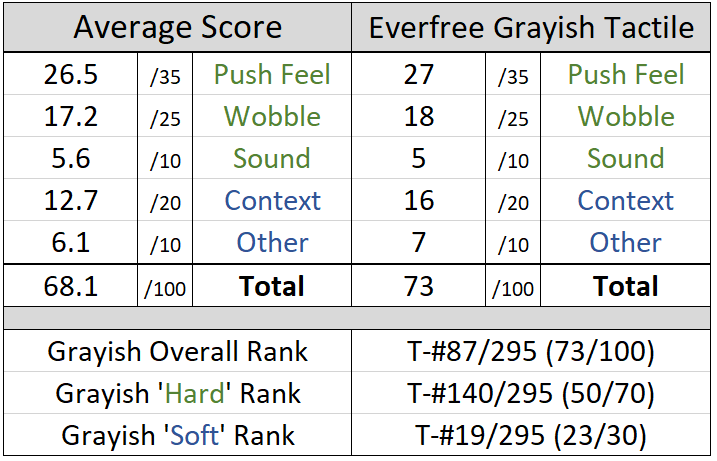Everfree Grayish Tactile Switch Review
Have any of you ever played this game before? Last weekend I downloaded Balatro, a “poker rogue-like” game that has insanely positive ratings on Steam, and I simply haven’t been able to stop playing it when I get home from work every day. Something about the simple game design, complex, puzzle-like interactions that are needed to be balanced between cards and ‘buffs’, and endless variations of games that you’ll encounter on account of its randomized design really does just suck you in if you even remotely enjoy card games. In fact, I think I’ve logged something like 20 hours in just 5 days of playing it now, and that is as a person who hasn’t really played video games all that much in a very long time. While I imagine that sort of time over a work week isn’t all that much compared to some of the more hardcore gamers out there among you, I was shocked to think I could stumble across a game that would bring me back into the play schedule I had back before I went to college. (Something about having progressively harder homework constantly hanging over your head for nearly a decade straight really does kill your general free gaming time…) If you ever have had any interest deck-building card games or have enjoyed poker games in general in the past, I simply can’t recommend this game enough and it’s more than worth the $15 to try it out on steam right now. Fair warning though – you will lose a ton of time playing it so don’t have any plans on being productive that week!
Figure 2: Also, don't play this game if you tilt easily. There's... a lot of losing involved.
To be entirely honest, I have no way to connect Balatro at the start of this review into the Everfree Grayish switches that I’m covering below. A lot of these intros more or less serve as time capsules for me looking back and I can pretty definitively say that the bulk of my life in the stretch of time between the last review and this one was eaten up by this game. I don’t always get to stumble across relevant life stories to tie to the switches, as unfortunate as that may be.
Switch Background
There’s no doubt that the tail end of 2023 and start of 2024 have been especially interesting times for new switch “manufacturers” and small pop-up brands of switches claiming independence. While the big name manufacturers we’ve all come to know and love continue to plug away at releases, there is a noticeably growing number of switches being released with newly minted brand names that are attempting (and largely failing) to act as if they are independently made and not propped up by just any other “big switch company” out there. Names like HTMZ, LCET, and HMX have been among the most convincing of these recently christened and expanding switch brands, with swathes of releases and varying degrees of differentiation from existing switch designs that suggest that they could at least plausibly be coming from their own factory. However, without concrete proof of life these switch brands could also very well just be offshoots of existing big name manufacturers, or direct sub-brands still made directly at those bigger production houses. Less convincingly, brands like FL CMMK, DareU, Akko, and Magegee are also striving to mark themselves as independent, though with volumes that are too small to clearly come from a single, new manufacturer. Among all of this chaos, however, one specific sub-brand of switches has quietly sprouted up and started gaining a noticeable amount of community interest – Everfree.
Coming to life at the very end of 2023, Everfree (also sometimes named as ‘EverFree’) is a newly formed sub-brand of switches that is produced by none other than Gateron. While Gateron has produced countless OEM and budget-friendly options for switches alongside their flagship designs throughout the years, the currently expanding lineup of Everfree switches are the first in… almost ever… to feature distinctive mold designs and nameplates that separate them from Gateron’s other switches out there. By comparison, this practice of designing molds and nameplates specifically for a new brand of switches to differentiate them from existing designs is infinitely more common at nearly every other large manufacturer (e.g. Kailh, BSUN, Durock/JWK, Tecsee, etc.) with the exception of basically only Cherry – who has never made MX-style switches without “Cherry” nameplates. To date, only a small handful of switches have ever been produced by Gateron with nameplates other than strictly “Gateron”, including Zeal 3-in-1 Clickiez, Drop Holy Panda X, Rantopad Oranges, and now the new Everfree sub-brand of switches. Furthermore, Zeal 3-in-1 Clickiez at least get a bit of an asterisk on this short list as they came by way of a design request by Zeal, an external party to Gateron, and still featured a ‘Gateron’ nameplate in addition to the ‘ZealPC’ one. Thus, the Everfree lineup are effectively the first and only switches since 2016 to have been produced by Gateron as standalone offerings without any Gateron branding on them whatsoever.
Figure 3: The shortlist of Gateron-made but not Gateron branded switches prior to the Everfree family of switches.
Figure 4: There's also supposedly normal stemmed Rantopad blue switches out there if this marketing photo is anything to believe. I have yet to see any of these out in the wild, however.
Currently, the Everfree/EverFree sub-brand of switches being released by Gateron is clearly being targeted towards the more budget-conscious end of the modern mechanical keyboard hobby, with a focus on price per performance over premium pdesigns. (I’m sorry, I just had to make that alliteration work.) As of the time of writing this review, the switches included in the Everfree family are a Gateron classic trio of Red, Yellow, and Brown switches in transparent/white housing constructions, linears in the form of ‘Curry’ and ‘Cedar’ switches, and a single, more customized tactile in the form of the ‘Grayish’ tactiles reviewed here. Generally speaking, nearly all of these switches in this family are available at price points below $0.40 per switch, with direct sales support from Gateron’s various western and eastern storefronts – something which isn’t all that common with large manufacturers and their sub brands. Aside from the clearly aforementioned and historically relevant nameplate differences between the Everfree line of switches and other existing Gateron offerings, other defining features of this switch brand include ‘EF’ branding on the underside of the bottom housings as well as the “FAT” LED condenser built into the top housings that will be covered in the paragraphs, below.
Figure 5: Original Everfree OEM trio featuring unique LED diffuser design front and center.
The Everfree Grayish tactiles, specifically, are the more ‘customized’ tactile offerings of the Everfree family with lengthened stem poles and a “heavy” tactile bump according to Gateron’s marketing for these switches. Coming in a polycarbonate over nylon construction, the Grayish tactiles also come with factory lubrication that is stated as being clearly different from the existing Gateron brand while still also having “high value and quality.” Released all the way back in December of 2023, the Grayish tactiles have expanded their reach quite a bit in only a few short months, being available across nearly a dozen different eastern and western facing vendors, all with varying degrees of pricing and switch sizes. Largely, though, all of these storefronts have prices which hover around or slightly above Gateron’s direct from manufacturer storefront pricing at $0.28 per switch, which only comes in the form of $30.80 for a 110 pack of switches. While the longevity and availability of these switches is a bit unknown given that Gateron has not spoken on such and they are still fairly new, the amount of marketing and time invested in this surprising new sub-brand by Gateron leads me to believe that these switches will be around for at least a few more years in the future.
Grayish Performance
Note: As mentioned above, ‘Everfree’ may also sometimes be referred to as ‘EverFree’. As well, these switches have been referred to by name of “Grayish”, “Grayish Tactile”, “EF Grayish Tactile”, and quite a few other variations. For the sake of consistency within this review, I will try and stick to the names ‘Everfree’ and ‘Grayish’, referring to the brand and switch, respectively.
Appearance
At the highest level, the Everfree Grayish switches come in an eponymously apt gray-ish colorway with gray-white translucent top housings, medium-gray opaque bottom housings, and white colored tactile stems. Amongst the broader backdrop of modern mechanical keyboard switches, these are fairly distinguishable just on this color scheme alone, however the “FAT” LED diffusers built into the top housings make this distinction just that much easier. A calling card of the Everfree brand of switches thus far into their history, these work to diffuse light from RGB compatible PCB designs rather well based upon at least what the marketing photos for the Grayish tactiles show on Gateron’s website. Beyond these most immediate eye catching details, there are still quite a few unique design quirks with the Everfree Grayish tactiles that both help in their identification and help separate them from Gateron’s other designs. These details are covered in the following paragraphs, below.
Figure 6: Everfree Grayish tactile switches and their components.
Figure 7: Example of colored LED light diffusion through Grayish tactile switches from Gateron's sales page.
Looking first to the milky, translucent polycarbonate top housings of the Everfree Grayish tactiles, these housings immediately demonstrate from the jump that Gateron has put efforts into making these design of these switches something standalone. Most notably is that of the LED/diode diffuser which has been mentioned already several times over in this review. Two thirds as tall as the front side of the top housing’s southern wall, this diffuser has a fingerprint-like series of concentric circular rings on the top side of the diffuser which don’t readily appear to serve any functionality to improving LED diffusion at all. Externally, the top housings also feature an inverted, italicized nameplate that reads ‘EverFree’, partially adding to the confusion as to whether or not the ‘f’ needs to be capitalized. Internally, the top housings don’t really appear to have any design quirks that make them unique and/or separate them from really any other modern switches available out there today, let alone from Gateron’s other offerings. The only details worth noting here that aren’t super obvious in the photos of the top housing interior, below, is that of the two capital letter mold markings located in the upper left- and right-hand corners of the housing underneath the nameplate region. Perhaps mentioning that the diffuser built into the top housings is not solid, and instead partially hollow, may be worth pointing out to some – though know that this isn’t all that uncommon in other switches which feature such designs, such as recent TTC offerings.
Figure 8: Everfree Grayish Tactile top housing external design showing inverted and italicized 'EverFree' nameplate and bulky LED light diffuser.
Figure 9: Everfree Grayish Tactile top housing interior design showing capital letter mold markings in upper left- and right-hand corners.
Moving next to the white, (assumedly) POM stems of the Grayish tactiles, these are surprisingly barren of any modern switch design flourishes and are notable in just how ‘basic’ they are compared to most other modern Gateron switches. While I understand that the Everfree switches were designed as being budget friendly, no extra frills switches which are easier to manufacturer, I would have at least expected that Gateron would still taper a slider rail, or make the stem pole at least a little more or less aggressively tiered. Instead, what is presented is a pretty bog-standard representation of an MX-style switch stem – squared off slider rails, normal looking center pole, mold ejector circles on the front plate, so on and forth. (This is minus the exception of the angled corners on the backplate of the switch, though it’s only an exception among all switches, as it has been seen before in other Gateron switches.) The stems are at least notable insofar that they are ‘long’ to reduce the overall travel distance of the stroke, coming in at 13.63 mm in length, which is a touch longer than the average stem length I’ve measured at 13.09 mm. (Current running average as of the time of writing is based on 492 other different switches measured.) What little factory lube was present on the stems of the switches was pretty evenly dispersed on the slider rail sides of the stem as well as a tiny bit on the stem legs, as well. While clearly not as heavy nor intentionally placed as in some of Gateron’s most premium offerings (e.g. Oil Kings), the application here is still pretty solidly done and is definitely still using some of Gateron’s improved lubing technology to do so.
Figure 10: Everfree Grayish Tactile stem front and back showing angled backplate cape, non-tapered slider rail, long stem pole, and front plate ejection mold circles.
Figure 11: Side profile of Everfree Grayish tactile stem showing profile of tactile bump.
Arriving to the opaque grey, nylon bottom housings of the Everfree Grayish switches, these again return to featuring quite a few design details which help separate them from Gateron’s other offerings. Internally, the first thing which jumped out to me is the general lack of free space in the base of the bottom housing. While bottom housing ‘roominess’ is not something I have often pointed to in this section, the aggressively large south-side spring collar really does make for a densely packed housing construction. Amidst this, though, you can still very well pick out dampening pads at the base of the slider rails as well as small mold ejection circles. Additionally interesting in the Grayish tactile is the presence of some different mold spots/padding structures on the upper rim of the bottom housings, most notably in the from of thin, vertical rectangles located around the hollowed out LED/diode slot section. Externally, these switches also feature quite a few mold markings which make them unique. In addition to the two single-letter mold markings in the lower left- and right-hand corners, these switches also feature a sideways ‘EF’ marking located between the metal PCB pins in similar fashion to “Gateron” anticounterfeit stamps located between these pins following the Stealios Controversy. If it wasn’t entirely clear from the photos below, these switches come in 5-Pin/PCB mount construction.
Figure 12: Everfree Grayish Tactile bottom housing interior design showing south side spring collar, dampening pads at bottom of slider rail, and assorted mold markings.
Figure 13: Everfree Grayish Tactile bottom housing exterior design showing capital letter mold markings in lower corner, 5-Pin/PCB configuration, and sideways 'EF' marking between metal PCB pins.
Push Feel
Upon first testing the Everfree Grayish tactile switches out, they read to me as a medium-heavy tactile switch with a wide tactile bump that starts towards the very top end of the downstroke and smoothly fades to an abrupt point at a stunted bottoming out. These switches might have the tiniest bit of linear pretravel to them, though admittedly I both don’t see it in the force curves and think that it is likely something that I’m just imagining in my head as I’m typing away at them on my tester. There really doesn’t feel like there is much, if any, of a post-bump linear region to the switch, which is in large part due to the lengthened stem pole cutting this section short and ending the downstroke at around 3.20 mm of total stem travel. In similar fashion to how I’ve done with other tactile switches in the past, I then went on to try and find a comparative switch to loosely toss in here for those of you who don’t make it all the way to the comparison section below. However, I could swear up and down that I’ve tried these tactiles before. Something about their bump, bottoming out, and overall feeling just echoed through my mind, leaving me continually searching for an apt comparison. That is, until I found one:
Figure 14: Comparative force curve diagram between Everfree Grayish Tactile and Gateron Root Beer Float switches.
Sorry for spoiling a fraction of the ‘Comparison to Other Notable Tactile Switches’ section below to those of you who were going to read it shortly, but this comparison simply couldn’t wait until that late into the article. The Everfree Grayish tactile switches, for all intents and purposes, present the same tactile bump as the Gateron Root Beer Float switches. Further making this comparison interesting is that the Grayish switches also seem to pull from the same mixed bag of intangibles as the Gateron Root Beer Floats did when it comes to smoothness, being decently smooth switches but with still a noticeable amount of smaller grain, slightly leathery feeling scratch. It’s nowhere near as bad as unlubed, dry switches from other certain manufacturers known for their scratch, though it is noticeable enough to impact the feeling of the actual downstroke and upstroke of these switches. As well, the Grayish switches do seem to have a bit of variability to them as well, much like the Root Beer Floats, with the tactile bumps feeling more scratchy in some switches than others, bottoming outs feeling mildly sharper than others, etc. That being said, though, these aren’t all that unexpected of features for a switch being sold at $0.28 each. If anything, the Grayish tactiles are surprisingly good about all of these shortcomings when contextualized with this price point in mind.
Figure 15: More or less how it mentally felt to make the connection between these two switches while taking notes for this review.
Sound
The sound of the Everfree Grayish tactiles, as subtle as it is, is largely driven by the scratch sound that permeates throughout the strokes of nearly every switch in the batch. Surprisingly, neither the polycarbonate top housing nor lengthened stem pole do much to impact the sound profiles of these switches around this scratch as well. Instead, all these two features do is act to add a barely pointed thud to an otherwise quiet overall tone. Unfortunately, both in terms of direct impact as well as due to its similarity to Gateron Root Beer Floats, the Grayish tactile switches also have a decent number of switches which have a pinging sound to them. Given the rounded, snappy nature of this metallic tone, I’m almost certain it is related to the interface between the stem legs and the leaves rather than a function of the spring in the switches. Thankfully, there is some differentiation between the Grayish tactiles and Gateron Root Beer Floats, here, as the nylon bottom housings of the Grayish switches lend to bottom outs which are more firm, muted, and less sharp sounding than the comparatively higher pitched, thinner sounding bottom outs onto the Ink thermoplastic bottom housings used in the Root Beer Floats.
Wobble
There is a noticeable but not likely super problematic amount of N/S and E/W direction stem wobble in the Everfree Grayish tactile switches. This stem wobble is equal in magnitude in these directions and doesn’t appear to vary across the batch that I received nearly as much as the scratch feeling and sound. While certainly more noticeable than in most other Gateron switches to date, this amount of wobble is quite good compared to other switches within this price range.
Measurements
If you’re into this level of detail about your switches, you should know that I have a switch measurement sheet that logs all of this data, as well as many other cool features which can be found under the ‘Archive’ tab at the top of this page or by clicking on the card above. Known as the ‘Measurement Sheet’, this sheet typically gets updated weekly and aims to take physical measurements of various switch components to compare mold designs on a brand-by-brand basis as well as provide a rough frankenswitching estimation sheet for combining various stems and top housings.
The latest in the content-adjacent work that I’ve picked up, the new ‘Force Curve Repository’ is now hosted on GitHub alongside the Scorecard Repository and contains all force curves that I make both within and outside of reviews. In addition to having these graphs above, I have various other versions of the graphs, raw data, and my processed data all available for each switch to use as you please. Check it out via the ‘Archive’ tab at the top of this page or by clicking any of the force curve cards above.
Break In
Break In Notes
17,000 Actuations
- At 17,000 actuations, the Everfree Grayish tactile switches do appear to break in quite noticeably, especially with respect to their smoothness increasing over the stock back of switches they were being compared to. However, this smoothness increase comes at a price as the switches also become much more pingy in terms of their overall sound and don’t really improve all that much in terms of switch to switch consistency.
- Like the vast majority of switches I’ve conducted break in testing on, the Everfree Grayish tactile switches also have a small, but noticeable amount of stem wobble increase after having been broken in a tiny bit.
34,000 Actuations
- In terms of strict performance notes, the Everfree Grayish tactiles broken in to 34,000 actuations haven’t really changed all that much than the batch of switches that was broken in to 17,000 actuations. I certainly feel as if the sound profile has morphed, somewhat, and is now much more driven by the ping and bottoming out sounds of the switch rather than the scratch that once largely dominated the sound profile of these switches.
51,000 Actuations
- It appears that beyond the 17,000 actuation mark where it was first noted, the Everfree Grayish tactile switches did not seem to greatly change when it came to stem wobble increase nor changes to their push feeling. These switches broken in to 51,000 actuations were effectively just as scratchy as those broken in to only 17,000 actuations.
- While the pinging sounds did not increase in the switches broken out to 51,000 actuations, the overall sound profile consistency from switch to switch begins to pretty substantially break down at this point in time. If you were to receive these switches broken in to at least this point in time, you almost certainly would have to cherry pick switches that had a similar enough sound profile for whatever build you’d be working on.
Figure 19: Comparative force curve diagram showing no distinctive trend in change of Everfree Grayish Tactile switch force curve diagrams throughout the break in process.
Comparison Notes to Other Notable Tactile Switches
Note – These are not aimed at being comprehensive comparisons between all factors of these switches as this would simply be too long for this writeup. These are little notes of interest I generated when comparing these switches to the Everfree Grayish Tactile switches side by side.
Figure 20: Switches for comparison. (L-R, Top-Bot: Cherry MX Purple, Zaku II, Drop Holy Panda X, Gateron Root Beer Float, Neapolitan Ice Cream, and KTT Matcha)
Cherry MX Purple
- While these two switches seem to have tactile bumps of fairly similar magnitudes when looking at the force curves below, the Cherry MX Purples feel a bit more strong in hand. I suspect this has a large part to do with the shortness of the bump in the MX Purples as compared to the long, drawn out nature of the bump in the Everfree Grayish tactiles.
- The Everfree Grayish switches have the tiniest bit less stem wobble in both the N/S and E/W directions than the Cherry MX Purples.
- Even though scratch is a much larger component of the sound profile of the Cherry MX Purples than it is for the stock Everfree Grayish switches, the lack of a pointed, abrupt bottoming out in the Purples makes them have a more cohesive, singular sound profile than the Grayish.
Zaku II
- There is a fair bit less stem wobble in the Everfree Grayish switches than the Zaku IIs in both the N/S and E/W direction.
- Of these two switches, there’s no doubt that the Zaku II switches are the sharper, stronger, and more punchy hitting of these tactiles. While the bottoming out isn’t as pronounced in the Zaku IIs as it is in the Everfree Grayish tactiles, the strength of the bump and it’s ‘two tone’ nature that I covered in depth in the review of the Zaku IIs more than makes their presence more notable.
- In terms of overall sound profiles, the Zaku II switches are not only a bit louder than the Grayish tactiles, but also a bit more ‘clear’ in their sound. By comparison, the scratch-forward nature of the Grayish tactiles makes their sound profile come across as much more fuzzy.
Drop Holy Panda X
- Much like with the Cherry MX Purple switch comparison above, the tactile bump of the Drop HPX switches feels quite a bit more punchy and in your face than the Everfree Grayish switches in spite of their similarity in their force curves. Unlike the MX Purples, though, I have little guess as to why this is that way.
- In terms of their overall sound profiles, these switches sound pretty surprisingly similar to each other. While the HPX switches are a bit more loud in their overall volume and have a bit more noticeable of bottoming outs than the Grayish tactiles, they’re similar enough that I imagine fans of one switches would enjoy the sound of the other.
- There is noticeably less stem wobble in the Holy Panda X switches than the Everfree Grayish tactile switches.
Gateron Root Beer Float
- If you just skipped down to this section and passed over the review above, I would highly encourage you to travel back up to the ‘Push Feeling’ section to see just how similar these switches are. The Gateron Root Beer Floats and the Everfree Grayish tactiles are something like 90% functionally similar in my opinion.
- One of the key differences between the Root Beer Floats and the Grayish Tactiles is that of their bottoming outs. The ‘Ink thermoplastic’ material sought out in the Root Beer Floats makes their housing collisions sound and feel a bit more thin, pointed, and distinct whereas the nylon used in the Grayish tactiles makes their bottoming outs feel and sound more soft and muted.
- As well, I could definitely make the argument that the Root Beer Floats are perhaps just the tiniest bit more smooth than the Grayish Tactiles, though its so close that I’m almost willing to assume this is batch to batch variation rather than something that is actually substantive that I’m noticing.
Neapolitan Ice Cream
- Once more for good measure, the Neapolitan Ice Cream switches feel as if their tactile bumps are a bit more pointed and noticeable in hand than the Grayish tactiles, despite even what the force curves below say.
- Of all of the switches on this list, the Neapolitan Ice Cream switches appear to be the only ones which have stem wobble in both N/S and E/W directions that is worse than the Everfree Grayish tactiles. This is not all that surprising considering the mold tolerances and general manufacturing quality of Tecsee in the era in which the Neapolitan Ice Creams were released.
- When comparing the overall sound profiles of these two switches together, the stock Neapolitan Ice Cream switches are both noticeably louder and scratchier than the Everfree Grayish tactiles – something which rarely happens simultaneously in a switch comparison.
KTT Matcha
- Strangely enough, even the KTT Matcha switches feel as if their tactile bumps are a bit more sharp and forceful under the fingers than the Everfree Grayish tactiles. Rather than being a function of differences in the width of the tactile bumps, I’m honestly willing to chalk this up to being caused by the pretty steep increase in force from start to finish across the bump in the Matchas.
- In terms of stem wobble, there is a bit less stem wobble in the N/S and E/W directions in the KTT Matcha switches than in the Everfree Grayish tactiles.
- Of all of the switches on this list, these two have the most similar sound profile to each other. That being said, the more pointed bottoming out of the Grayish tactiles makes their housing collisions a bit more distinct and loud than the Matchas.
Scores and Statistics
Note – These scores are not necessarily completely indicative of the nuanced review above. If you’ve skipped straight to this section, I can only recommend that you at least glance at the other sections above in order to get a stronger idea of my opinion about these switches.
Push Feel
The medium-high strength tactile bump in the Everfree Grayish tactile switches is one that hits rather early on in the downstroke and slowly tapers off into an abrupt bottoming out to the stem pole at only 3.20 mm of total travel distance. While this profile, in and of itself, has been successful in other tactile switches before it, there is a noticeable amount of small grain, leathery scratch throughout the stroke that does detract from the overall feeling of the switch. As well, there are some switch-to-switch inconsistencies in these points, but those are much more noticeable in the sound than the push feeling.
Wobble
For budget bin options, the Grayish tactiles pack a noticeable but certainly not problematic amount of N/S and E/W direction stem wobble that is equal in magnitude.
Sound
In addition to the aforementioned scratchy tones, there is a sporadically present amount of ping in any batch of these switches which is likely due to the stem/leaf interaction point. If you can get around this issue, however, the overall muted tone that these carry with softened, thick housing collisions is a bit pleasant for a switch as tactile as these.
Context
Currently the most notable of Gateron’s newest budget sub-brand of switches in Everfree, these switches are available damn near everywhere it seems and at a pretty remarkable price point for their performance points and quirks. The price is even more so justified when considering that these are extremely similar to Root Beer Floats, which commanded much higher prices…
Other
The Everfree Grayish tactile switches are ones which have not only have strong promise of being around for a long time at their pricing point, but are a historically relevant inflection point in Gateron’s manufacturing. I imagine that these will not be forgotten for quite some time to come.
Statistics
If you are looking at this statistics section for the first time and wondering where the hell are the other 294 switches that I’ve ranked are, or what ‘hard’ versus ‘soft’ ranks refer to specifically, I’d encourage you to head on over to my GitHub linked in the table above or at the links in the top right hand of this website to check out my database of scorecards as well as the ‘Composite Score Sheet’ which has a full listing of the rankings for each and every switch I’ve ranked thus far.
Final Conclusions
The Everfree Grayish switches are tactiles that pack in a medium-high strength tactile bump that slowly fades out until an abrupt, shortened bottoming out due to the longer stem pole in these switches. In spite of factory lubing and care put into them by one of the better switch manufacturers in recent years in Gateron, these switches also feature a noticeable amount of small grain, leathery scratch and a sporadic stem/leaf ping that is present throughout a batch though unpredictably. These switches also break in in a fairly mediocre fashion, with their scratchiness going down over time but general inconsistencies going up, and especially so with their sound profile. Necessarily speaking, none of these design features nor quirks are all that unexpected for an average Gateron offering, and doubly so when considering the price point that these switches are being sold at – ranging from $0.28 to $0.40 per switch depending on where they are being brought from. In releasing these switches, Gateron distinctly and deliberately went out of their way to produce these for their newest budget-friendly sub-brand in Everfree, and I’d say they managed to hit the performance at that price point pretty damn well. What is surprising in all of this, though, is that Gateron hit these performance notes in the Grayish tactile switches in nearly identical fashion as to how they did so with the Gateron Root Beer Float switches designed by PuNkShoO and released all the way back in March of 2023. That’s right – every single one of these objective descriptions above, save for price, can nearly perfectly substitute the Root Beer Floats in place of the Grayish tactiles.
To say that I have mixed feelings about this situation would be an understatement. On one hand, the Everfree Grayish switches are rather strong performing tactile switches for their price point and are pretty good non-OEM tactile offerings for Gateron to help develop their Everfree sub-brand further. This new brand of switches being released by Gateron, as well, is an incredibly good idea in my mind and I think that of all large manufacturers currently, Gateron is the best equipped to truly make a budget friendly line of switches that are that budget friendly. However, damn near directly ripping off the design and execution of a custom switch design that you fulfilled at the request of a customer for your new budget friendly line of switches feels honestly a bit scummy. Yes, I’m sure they’ll point to the fact that the top housings have new molds and that the bottom housings were made out of nylon instead of ‘Ink thermoplastic’ material as clear signs that these switches are in fact different, and they wouldn’t be wrong in doing so. Though, when the physical measurements, the force curves, and the in-hand tests all point to these two switches being almost functionally identical in use, it’s kind of hard to argue that those differences are sufficient enough. Sure, you could also probably point out that Gateron owns the molds and designs to the Root Beer Floats, and so its not as if this is blatant “IP theft” or a rip off of a collaborator’s owned molds like with someone like Zeal. That being said, is putting virtually no effort into designing a flagship tactile for your new sub-brand you’ve poured substantial money into effort a good idea? I am hard pressed to think so. I imagine that fans of the Gateron Root Beer Float switches will be incredibly happy that they can now get 90% similar switches to their favorites at a heavily discounted price. I, on the other hand, am not so sure I am on board with this practice from a switch vendor with as large of capabilities and R&D as a place like Gateron. It’s a shame too – I had a lot higher expectations of the Everfree line of switches than this ostensible design strategy and I would have imagined that more effort would have gone into making the Everfree Grayish tactiles truly different instead of just a rehash of something already released before.
Sponsors/Affiliates
Mechbox UK
- A wonderful UK based operation which sells singles to switches that I’ve used above in my comparisons for collectors and the curious alike. Matt has gone out of his way to help me build out big parts of my collection, and buying something using this link supports him as well as my content!
KeebCats UK
- A switch peripheral company based out of the UK which sells everything switch adjacent you could ask for, they’ve been a huge help recently with my film and lube supply for personal builds, and they want to extend that help to you too. Use code ‘GOAT’ for 10% off your order when you check them out!
proto[Typist] Keyboards
- An all-things keyboard vendor based out of the UK, proto[Typist] is a regular stocker of everything from switches to the latest keyboard and keycap groupbuys. While I’ve bought things from the many times in the past, they also are a sponsor of my work and allow me to get some of the great switches I write about!
Divinikey
- Not only do they stock just about everything related to keyboards and switches, but they’re super friendly and ship out pretty quick too. Divinikey has been a huge help to me and my builds over the last year or two of doing reviews and they’ll definitely hook you up. Use code ‘GOAT’ for 5% off your order when you check them out!
ZealPC
- Do they really need any introduction? Zeal and crew kicked off the custom switch scene many years ago with their iconic Zealios switches and the story of switches today couldn’t be told without them. Use code ‘GOAT’ (or click the link above) for 5% off your order when you check them out!
MechMods UK
- A rising vendor based in the UK, Ryan and crew have been a pleasure to work with and have nearly everything you’d need to build your first or fourteenth keyboard. Go build your latest or greatest one right now with them by using code ‘GOAT’ at checkout for a 5% discount!
Dangkeebs
- A longtime supporter of the website and the collection, Dangkeebs has quite possibly the widest variety of switches of any vendor out there. Not only is their switch selection large, but it rotates and is constantly adding new stuff too. You’re going to need 5% off your order with my affiliate to save off the cost of all those switches!
SwitchOddities
- The brainchild of one my most adventurous proxies, SwitchOddities is a place where you can try out all the fancy, strange, and eastern-exclusive switches that I flex on my maildays with. Follow my affiliate code and use code ‘GOAT’ at checkout to save 5% on some of the most interesting switches you’ll ever try!
Cannonkeys
- Does anybody not know of Cannonkeys at this point? One of the largest vendors in North America with keyboards, switches, keycaps, and literally everything you could ever want for a keyboard always in stock and with an incredibly dedicated and loving crew. Follow my affiliate link above in their name to support both them and I when you buy yourself some switches!
Kinetic Labs
- One of the most well-rounded keyboard vendors out there, Christian and crew have been supporters of all my switch and switch-adjacent needs for some years now. I’m honored to have them as an affiliate and think you should check them out using my affiliate link above to support both them and I when you check out their awesome products!
Keebhut
- Want to try out some switch brands that fly under most vendor’s radars? Keebhut is always seeking out that next latest and greatest and has been super helpful in hooking me up with new brands over the past year. They are all about sharing that love as well, and want to give you 5% off your next order with them when you use code ‘GOAT’ at checkout!
Further Reading
Gateron’s Everfree Grayish Tactile Sales Page
Cannonkeys’ Everfree Grayish Tactile Switch Sales Page
Kinetic Labs’ Gateron EF Grayish Tactile Switch Sales Page
Divinikey’s Gateron EF Grayish Tactile Switch Sales Page
SwitchOddities’ Gateron EverFree Grayish Sales Page


